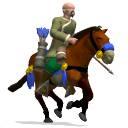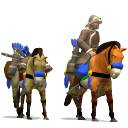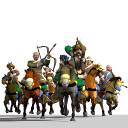pedrov said:Egat! Someone found answers to the Khmer question!
Good Heavens! -- You sound surprised.

pedrov said:Egat! Someone found answers to the Khmer question!

Mistfit said:The seven statues, which stood between 1.3 to 2.7 meters (4 to 10 feet) tall, were inscribed with the names of five of Nubia's kings: Taharqa, Tanoutamon, Senkamanisken, Anlamani, and Aspelta.
King Taharqa, perhaps the most glorious Nubian king who also reigned over Egypt.
From this <<<Website<<<
ozymandias said:Good Heavens! -- You sound surprised.
 would have been the best answer). That's what's so cool about this... lots of insanely obscure knowledge. It's like a bunch of trekkies on a sugar buzz
would have been the best answer). That's what's so cool about this... lots of insanely obscure knowledge. It's like a bunch of trekkies on a sugar buzz  !
!ozymandias said:I'm setting up the Mongols in one mod to be quasi-barbarians: they're a Civ that starts with one city and cannot build settlers. I need two names: one for a zero-movement "guard" unit and one for the improvement which spits out a Keshik every couple of turns. Any ideas? (e.g., whatever name the Mongols used for their roving capital would work for the improvement; was there an elite guard I could name the guard unit after?)
 Thank you for some amazingly useful info. I can see I'll be "fleshing out" the Mongols with "ordus" (probably for the "home guard") and "darogas" (unique trading posts?) etc.
Thank you for some amazingly useful info. I can see I'll be "fleshing out" the Mongols with "ordus" (probably for the "home guard") and "darogas" (unique trading posts?) etc.mrtn said:Hm, I have a vague memory of reading here at cfc about the meaning of "Keshik", that that's an elite guard...




ozymandias said:@pedrov:Thank you for some amazingly useful info. I can see I'll be "fleshing out" the Mongols with "ordus" (probably for the "home guard") and "darogas" (unique trading posts?) etc.
Oz
Mistfit said:@ozymandias - Have you looked at the info grom the GOTM25? There was an Ordu Archer UU
 !
!Mistfit said:http://forums.civfanatics.com/showpost.php?p=1650124&postcount=2
A different mongol Cav unit here
I edited the post above to include a link to Kinboats Mongol Horde
 ... thanks a bundle.
... thanks a bundle.Madeira said:Anyone? Im doing final modifications to my mod/scenario and one of the modifications was the addition of the Sarmatian civilization. It can represent both sarmatian, schytian (spelling?), dacian or any neighbooring civ, i just need some city and leader names for it. Im going to use both Sarmatian Swordsman and Eastern Cataphract as unique units for them.
My mod is called Civilization: Evolution, it starts after the trojan war and goes all the way to the future age, open ended, earth map. Im releasing a preview version that has the ancient age fully working once im done with these last modifications. If you want more info please check the CDG forums, it has its own section, scroll down until you find "MOD: Civilization: Evolution". I'll post some more info here at civfanatics when i do release the preview version.
This being my favored tribe out of themSAKÂ HÂUMAVARGÂ (Haoma-drinking Sakae) These tribes, called Amyrgoi by Herodotus, were known for their ritual use of Haoma, a hallucinogenic drug made from the fly agaric mushroom.
![Pimp [pimp] [pimp]](/images/smilies/pimp.gif)
